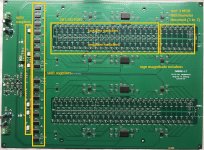I just received the 5 MHz package. Cheers Andrea for your dedication and staying on top that I receive the package.
This should be or close to being the last order from the last group buy since I purchased the last board and crystal available.
Thanks also for offering the finished board option. No way I would attempt this solution without a finished board. I don't plan to implement until last quarter of the year.
EDIT: Any links where to purchase the Neoprene decoupling? Can I use vibration decoupling car audio products? I already have the sample pack.

Sample Pack of our 9 Most Popular Products - Second Skin Audio
I think the OverKill Pro product might work (Video with Wine glass and Sub):
OverKill Pro: Closed Cell Foam Sheets for Cars - Second Skin Audio
This should be or close to being the last order from the last group buy since I purchased the last board and crystal available.
Thanks also for offering the finished board option. No way I would attempt this solution without a finished board. I don't plan to implement until last quarter of the year.
EDIT: Any links where to purchase the Neoprene decoupling? Can I use vibration decoupling car audio products? I already have the sample pack.

Sample Pack of our 9 Most Popular Products - Second Skin Audio
I think the OverKill Pro product might work (Video with Wine glass and Sub):
OverKill Pro: Closed Cell Foam Sheets for Cars - Second Skin Audio
Last edited:
You can also try gel
@A123
Neoprene gel?
Do you have a link?
I'm going to start researching some isolation solutions for my next Mouser project order.
dac lite
hi andrea,
what will be the specs and differences between the dac-lite and the dac-heavy ?
?
has the dac-lite a balanced output? what will be the output voltage and impedances?
thanks and best wishes
It's a multibit sign magnitude segmented R2R DAC with digital calibration when used with the FIFO Lite.
hi andrea,
what will be the specs and differences between the dac-lite and the dac-heavy
has the dac-lite a balanced output? what will be the output voltage and impedances?
thanks and best wishes
Hi,
the DAC Lite does not provide balanced output, but maybe you could get the balanced output using a couple of board, since the FIFO lite provides reversed data.
I have to check.
It's a voltage output DAC, around 2V rms and around 300 ohm impedance.
The top version of the DAC is not yet fully defined, so I cannot yet explain the difference.
the DAC Lite does not provide balanced output, but maybe you could get the balanced output using a couple of board, since the FIFO lite provides reversed data.
I have to check.
It's a voltage output DAC, around 2V rms and around 300 ohm impedance.
The top version of the DAC is not yet fully defined, so I cannot yet explain the difference.
I attach a picture of the DAC Lite prototype.
It's a 24 bit 192kHz DAC (384 kHz to be tested).
It implements sign magnitude notation so the MSB does not switch during zero crossing.
It uses a segmented architecture, the first 3 MSB are thermometer decoded (in order to lower the glitch) while the other 20 bit are R2R decoded.
It's a voltage output DAC so it does not need a I to V conversion stage, although a buffer is recommended.
It uses a custom protocol and when used with the FIFO Lite the ladder resistor network can be digitally calibrated to reach the best linearity up to 22-23th bit.
It works with stopped clock in order to avoide any interference from the BCK during the word transiction.
The dirty signals like DATA and BCK are optically isolated from the DAC to avoid interference with the crucial LRCK signal.
It runs up to 24 bit/192 kHz with 5.6448 MHz and 6.144 MHz clocks.
It needs +/- 3V3 clean power supply, battery suggested.
It's a 24 bit 192kHz DAC (384 kHz to be tested).
It implements sign magnitude notation so the MSB does not switch during zero crossing.
It uses a segmented architecture, the first 3 MSB are thermometer decoded (in order to lower the glitch) while the other 20 bit are R2R decoded.
It's a voltage output DAC so it does not need a I to V conversion stage, although a buffer is recommended.
It uses a custom protocol and when used with the FIFO Lite the ladder resistor network can be digitally calibrated to reach the best linearity up to 22-23th bit.
It works with stopped clock in order to avoide any interference from the BCK during the word transiction.
The dirty signals like DATA and BCK are optically isolated from the DAC to avoid interference with the crucial LRCK signal.
It runs up to 24 bit/192 kHz with 5.6448 MHz and 6.144 MHz clocks.
It needs +/- 3V3 clean power supply, battery suggested.
Attachments
The positive and the negative references voltage could be a little different, to be measured if the distortion will be negligeable.
Usually we don't like to design for the lowest THD but if it will be too high we add a tracking regulator after the battery.
We will also try LTO battery.
Usually we don't like to design for the lowest THD but if it will be too high we add a tracking regulator after the battery.
We will also try LTO battery.
- Home
- Group Buys
- The Well Tempered Master Clock - Group buy

